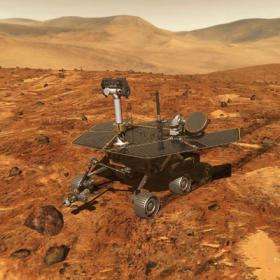Opportunity Recovers from Brief Operational Anomaly

While Opportunity was collecting images with the panoramic camera on the rover's 902nd Martian day, or sol (Aug. 7, 2006), a spacecraft anomaly at 11:19 a.m. local solar time caused the rover's fault protection software to interrupt operations, place the rover in a safe state, and reboot the flight software.
Upon waking up after the reset, Opportunity flagged the positions of the high-gain antenna and pancam mast assembly as unknown. Opportunity then remained in automode (meaning the rover did not attempt to execute a master sequence of activities for the day).
The rover's handlers transmitted instructions to Opportunity to re-establish the position of the high-gain antenna on sol 903 (Aug. 8, 2006) and the position of the pancam mast assembly on sol 904 (Aug. 9, 2006). Sols 903 and 904 were primarily dedicated to retrieving diagnostic information.
On sol 904, Opportunity successfully reacquired the sequence of panoramic camera images that had been terminated by the fault and collected scientific data. As of sol 905 (Aug. 10, 2006), Opportunity was completely restored to normal operations. Opportunity remains healthy and engineers have not found a credible explanation for what caused the anomaly.
Before the fault, Opportunity had been working on a campaign of science observations of the area around "Beagle Crater," including an analysis of laminated ripples using instruments on the rover's robotic arm. Opportunity has resumed work on those observations.
Sol-by-sol summaries
Sol 900 (Aug. 5, 2006): Opportunity made tau observations (measurements of dust opacity in the atmosphere) using the panoramic camera and completed two image mosaics of Beagle Crater with the panorama camera: a four-by-four mosaic known as "Beagle Pan B" and a two-by-four mosaic known as "Beagle Pan D."
Opportunity acquired images of a target known as "Fernandina" using all 13 filters of the panoramic camera and made observations of a target known as "Darwin" with the miniature thermal emission spectrometer. The rover acquired morning panoramic camera images of targets "Camarhynchus" and "Cactospiza" and a portion of the sky. Opportunity checked for drift (changes with time) in the miniature thermal emission spectrometer and surveyed the sky and ground with the same instrument.
Sol 901: Opportunity made tau observations using the panoramic camera and completed two image mosaics of Beagle Crater with the panorama camera: a four-by-four mosaic called "Beagle Pan A" and a four-by-four mosaic called "Beagle Pan C."
Opportunity acquired images of a target known as "Floreana" using all 13 filters of the panoramic camera. The rover acquired miniature thermal emission spectrometer data from Camarhynchus and a target called "Geospiza." Opportunity acquired panoramic images of a target known as "Platyspiza."
Sol 902: Opportunity made tau observations with the panoramic camera. At 11:19 a.m. local solar time, a spacecraft fault put the rover in a safe state.
Sol 903: Opportunity ran engineering sequences to recover from the previous day's fault responses and retrieve diagnostic data.
Sol 904: Opportunity acquired stereo images with the navigation camera without activating the pancam mast assembly and ran engineering sequences to complete the rover's recovery from the fault that occurred on sol 902. Opportunity took images of the calibration target for the panoramic camera and re-acquired "Beagle Part 5," the sequence of images that was terminated by the fault on sol 902.
Sol 905: Opportunity made tau observations using the panoramic camera, acquired a two-by-one mosaic of Darwin with the panoramic camera, and acquired images of Geospiza using all 13 filters of the panoramic camera. The rover scanned for clouds using the navigation camera's wide field of view. Opportunity also checked for drift in the miniature thermal emission spectrometer and surveyed the sky and ground with the same instrument.
Sol 906 (Aug. 11, 2006): Plans called for Opportunity to take tau measurements with the panoramic camera, monitor dust on the pancam mast assembly using the miniature thermal emission spectrometer, survey the ground and sky at various elevations using the miniature thermal emission spectrometer, and collect reference data from the calibration target for the thermal emission spectrometer. During this procedure, the rover was to check for drift (changes over time) in measurements from the instrument.
Odometry
As of sol 897 (Aug. 2, 2006), Opportunity's total odometry was 8,687.56 meters (5.4 miles).
Copyright 2006 by Space Daily, Distributed by United Press International





















